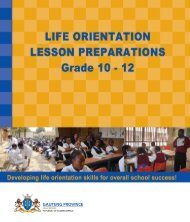Life Science Grade 11
Life Science Grade 11
Life Science Grade 11
You also want an ePaper? Increase the reach of your titles
YUMPU automatically turns print PDFs into web optimized ePapers that Google loves.
<strong>Grade</strong> <strong>11</strong> <strong>Life</strong> <strong>Science</strong>s Lesson Plans• Explain to learners that the two essential whorls of a flower are thefollowing :• Androecium or stamen ( male whorl) - consisting of the anther andfilament• Gynaecium or pistil ( female whorl) – made up of stigma, style andovary• Explain to learners that only :• A ripe anther produces pollen with male gametes.When female gametes are formed in the ovules, the stigma becomes ripeand sticky to receive pollen• Self – pollination is the transfer of pollen between the anther and thestigma of the same flower e.g. Orchids, pea plants• Cross – pollination is the transfer of pollen from the ripe anther of oneflower to the ripe stigma of another flower.• Also indicate to learners that the fruits that they eat are actuallyswollen ovaries after a flower has undergone sexual reproduction.• Tell learners what the importance of the corolla is:• Corolla – made up of petals to attract insects for pollination.• Ask the following question :• Why are some flowers small and dull while others are big and brightlycoloured?• Answer: Small, dull flowers are wind pollinated. Big, bright flowers areinsect or bird pollinated and has nectarines/ nectar glands.• Explain to learners that all flowers are structurally suited for a specificTerm 1 Page 46© Gauteng Department of Education (CAPS version)







